We arrived in Big Bend National Park after spending some time with our friends in Fort Davis and Alpine TX. Unfortunately, Duane and Dona had to leave and go back to Dallas, Dona hurt her foot and had to go see the doctor, we wish her the best of recovery.
David and Lana came with us to see the Big Bend, like us, it was their first time there.
The first full day we decided to do a Jeep tour to familiarize ourselves with the area and what it had to offer. We were lucky enough to meet our guide “extraordinaire”, Elizabeth.

This tiny lady drove the jeep on the steep rocky bad roads like there was nothing to it, and her knowledge of the area was extensive. Thanks to her, we learned that to appreciate the desert, you have to look up-close. An overview from the highway is not enough, you do need to get up close and personal with the desert. It hides tiny signs of life, fossils hidden in the rocky soil and a rich fauna.
This is really the “Last Frontierâ€, the people here have a “pioneer” spirit, they are independent and resourceful. When you buy a land parcel here, and you want to build a house, you better be prepared to build it yourself. You may end up living in a tent of an RV trailer for months, while you are building. There are no building codes, so you are free to come up with the most unusual ideas and put them to use. The closest building material supplier is about 400 miles away in Del Rio and there are no construction companies in the Big Bend area. Most people, unless they want to build their house directly on the side of the highway, are living off-grid. Solar systems and windmills are used to provide electricity, rain water is collected in cistern systems to fill the water needs.. Wells are cost-prohibitive, and the ground water is too alkaline to be used without extensive water treatment. When we were there, there had been no rainfall since the previous September, so water conservation is a must. Kids living here are frequently home-schooled, although there is a school in the area. People help each others, like in the old days. Needles to say, if you want peace and quiet, if you want to live off-grid, and you don’t mind the dryness, the wind, the heat and the dust, this would be paradise.
Elizabeth, our guide, fell in love with the area while traveling here, she used to work for 5 or 6 years and save money enough to take 1 or 2 years off to travel the world. Strangely, she said that it never hurt a career, on the contrary, employers found it intriguing and appreciated the qualities that come with this kind of independence. She now lives here during the winter, works two part-time jobs, and then goes to North Carolina in the summer where she holds another job, she said that it was not uncommon for people to do this in the area.
The Big Bend area used to be a sea, billions of years ago, that is why most of the soil is composed of sandstone and the sea creatures fossils are abundant.
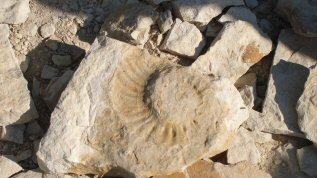

The sea moved to the south and the soil dried up, then intense volcanic activity took place, approximately 17 million years ago, pushing magma through cracks in the ground to form dikes, great stone fences that can be traced for miles across the park. Waves of magma underground formed the rounded mountains, and angular blocks resulted in stratified layers of lava and ash, the scenery is living proof what was once a giant volcanic battleground.
Depending on the elevation, the vegetation changes dramatically, you go from the lower plains, where the vegetation is sparse, composed mostly of creosote bushes, and as you go up, there are more and more variety of desert plants, to finally end up at high elevation in a forest of junipers, oaks and Mexican Piñons, if you hike even higher, you would find Douglas Firs and Arizona Pines. The change is so dramatic, that by looking at what variety of plants is growing, you can guess your elevation.
This used to be Apache territory, and the Indians knew how to use the land and its resources, most plants growing here have many uses, as food, medicine, sewing and building material.
Although the bare desert may look like a no-mans land, when you mix desert vegetation with gigantic rocks in tones of ochre, burnt sienna and rust, you end up with the most magnificent landscape, one that could compete without a problem with the best work of landscape architects.
We were there while the Ocotillo was in bloom, I totally fell in love with this one, and on top of that the blooms are edible! Full of vitamin C! Many of he cacti were also beginning to bloom.
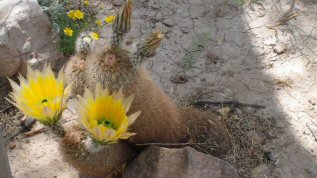
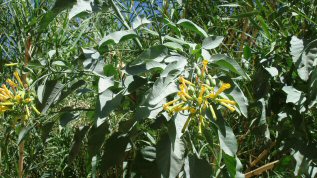
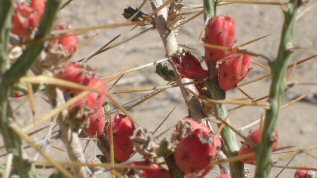
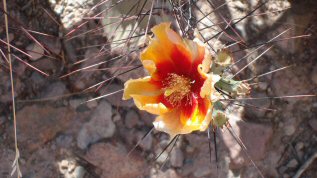
David and Lana have a 4 wheel-drive vehicle so we hopped in with them and they took us on remote, rough gravel roads. We hiked trails (and Bear did very well). At the end of a trail, hidden in a canyon, we found this dry waterfall, look at the sheer size of it.
The last day we hiked a 2 mile trail, including a quarter mile climb at the end, up a very steep rocky trail to go see the “window rockâ€, a gigantic boulder balancing itself on top of 2 other boulders, it was a tough climb and my legs still feel the effect, but it was worth it. Bear waited for us at the foot of the hill, it would have been foolish for him to risk dislocating a hip or braking on of his knees on this trail, but he had company, there are a lot of people who decided not to attempt the climb.
Farming took place here, when the desert was a giant grassland in the 1880’s after the Indians were pushed out of the area. Overgrazing killed the grass and by the mid 1900’s, the farms were abandoned, there are still ruins of adobe buildings and working windmills and wells that are left from this era. Around the wells that are still working, the vegetation forms little oasis for plants and animals, strangely the temperature is noticeably lower and breezy in those areas.
The Rio Grande (or Rio Bravo as our Mexican neighbours call it) is the border between the United States and Mexico.